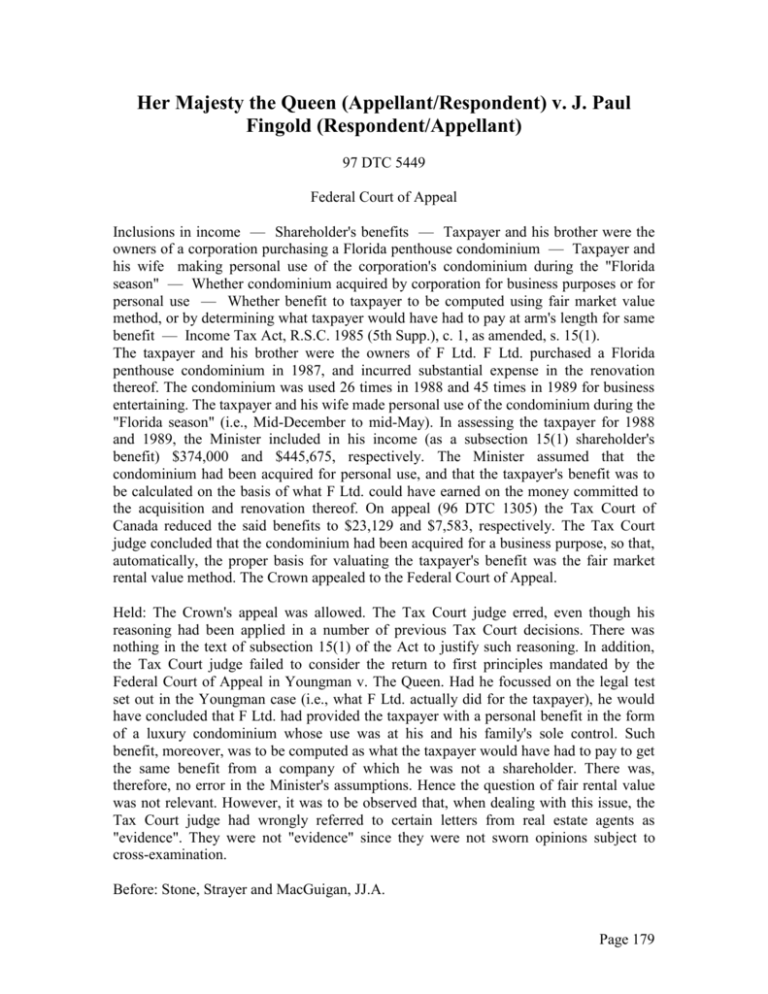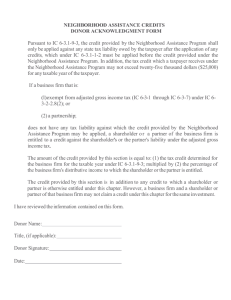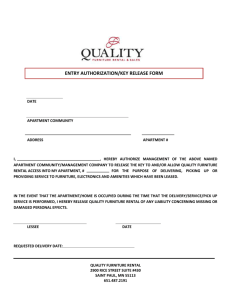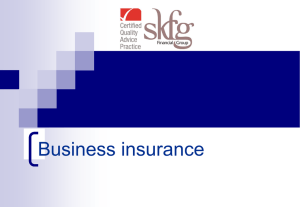Fingold (FCA)
advertisement

Her Majesty the Queen (Appellant/Respondent) v. J. Paul Fingold (Respondent/Appellant) 97 DTC 5449 Federal Court of Appeal Inclusions in income — Shareholder's benefits — Taxpayer and his brother were the owners of a corporation purchasing a Florida penthouse condominium — Taxpayer and his wife making personal use of the corporation's condominium during the "Florida season" — Whether condominium acquired by corporation for business purposes or for personal use — Whether benefit to taxpayer to be computed using fair market value method, or by determining what taxpayer would have had to pay at arm's length for same benefit — Income Tax Act, R.S.C. 1985 (5th Supp.), c. 1, as amended, s. 15(1). The taxpayer and his brother were the owners of F Ltd. F Ltd. purchased a Florida penthouse condominium in 1987, and incurred substantial expense in the renovation thereof. The condominium was used 26 times in 1988 and 45 times in 1989 for business entertaining. The taxpayer and his wife made personal use of the condominium during the "Florida season" (i.e., Mid-December to mid-May). In assessing the taxpayer for 1988 and 1989, the Minister included in his income (as a subsection 15(1) shareholder's benefit) $374,000 and $445,675, respectively. The Minister assumed that the condominium had been acquired for personal use, and that the taxpayer's benefit was to be calculated on the basis of what F Ltd. could have earned on the money committed to the acquisition and renovation thereof. On appeal (96 DTC 1305) the Tax Court of Canada reduced the said benefits to $23,129 and $7,583, respectively. The Tax Court judge concluded that the condominium had been acquired for a business purpose, so that, automatically, the proper basis for valuating the taxpayer's benefit was the fair market rental value method. The Crown appealed to the Federal Court of Appeal. Held: The Crown's appeal was allowed. The Tax Court judge erred, even though his reasoning had been applied in a number of previous Tax Court decisions. There was nothing in the text of subsection 15(1) of the Act to justify such reasoning. In addition, the Tax Court judge failed to consider the return to first principles mandated by the Federal Court of Appeal in Youngman v. The Queen. Had he focussed on the legal test set out in the Youngman case (i.e., what F Ltd. actually did for the taxpayer), he would have concluded that F Ltd. had provided the taxpayer with a personal benefit in the form of a luxury condominium whose use was at his and his family's sole control. Such benefit, moreover, was to be computed as what the taxpayer would have had to pay to get the same benefit from a company of which he was not a shareholder. There was, therefore, no error in the Minister's assumptions. Hence the question of fair rental value was not relevant. However, it was to be observed that, when dealing with this issue, the Tax Court judge had wrongly referred to certain letters from real estate agents as "evidence". They were not "evidence" since they were not sworn opinions subject to cross-examination. Before: Stone, Strayer and MacGuigan, JJ.A. Page 179 Introduction Strayer, J.A. (Stone and MacGuigan, JJ.A. concurring): This is an appeal from a decision of the Tax Court of Canada in which the assessment by the Minister of the respondent's income for the 1988 and 1989 taxation years was set aside and the matter referred back to the Minister for reconsideration and reassessment. The matter in issue is the value of benefits received by the respondent as a shareholder for purposes of inclusion in his income pursuant to subsection 15(1) of the Income Tax Act. The Minister had assessed the value of these benefits as $374,000 in respect of 1988 and $445,675 in respect of 1989. The learned Tax Court judge ordered a reassessment on the basis that the correct figures were, respectively, $23,129 and $7,583. The Minister's assessment was based on the equity rate of return method. The trial judge adopted instead the fair market rental value as a basis for calculating the benefits. Facts It appears that the trial judge relied on the following facts in coming to this conclusion. At the time in question the respondent and his brother were the owners of Fobasco Limited ("Fobasco"), a holding and management company which controlled Slater Industries Ltd. ("Slater"), a public corporation. Slater was a steel producer but had various divisions including a trucking operation. Fobasco also had shares in several other companies. Slater and some of the other companies did extensive business in the United States. For a number of years the respondent's mother had had a condominium in Palm Beach, Florida. Her family would visit her there for vacations. In 1987 a penthouse condominium in the same building became available and Fobasco purchased it for $1,800,000 (Canadian) and then proceeded to renovate and furnish it at a further cost of about $2,200,000 (Canadian). This was an apartment of 4,610 square feet with, after the renovations, 5 bedrooms each with their own bath and a kitchen "upgraded to restaurant standards". The renovation and furnishing of this apartment was all carried out under the supervision of the wife of the respondent. According to a log kept by Mrs. Fingold during the two taxation years in question the apartment was used for business entertaining on twenty-six occasions in 1988 and fortyfive occasions in 1989. On only one occasion did a business guest remain overnight, the rest of the entertaining consisting of dinner, lunch, or breakfast or cocktails. The respondent and his wife made personal use of the apartment during the Florida season which the trial judge defined as mid-December to mid-May, approximately 151 days. The respondent travelled extensively but his wife remained at the apartment for most of this time. Occasionally his brother entertained at the apartment although it is not specified in the judgment what the nature of this entertaining was. The respondent and his brother personally paid for the operating costs of the apartment. Page 180 The Tax Court judge accepted the evidence of the respondent that the apartment had been acquired by Fobasco for the purpose of business entertaining. He noted that the dressing room of the master bedroom was equipped as an office. The learned Tax Court judge therefore concluded that the condominium had been acquired for a business purpose and had been used for business purposes. In his view it automatically followed that the proper basis for valuation of the benefit received by the respondent through his personal use of the apartment would be fair market rental value which he found to be $60,000 per year, basing himself on two letters from Florida realtors. He regarded these as "evidence". He then proceeded to allocate this rental value as between time devoted to personal use and time devoted to business use. He appears to have regarded each occasion for business entertainment at the apartment, even if only involving a meal or cocktails, as involving a whole day of exclusive business use and precluding any personal use. From the amounts so apportioned for personal use he deducted the expenses incurred by the respondent for the operation of the apartment, producing the amounts at which he has directed the Minister to assess the value of the subsection 15(1) benefits. It appears that the respondent had reported benefits for these two years based on the assumption that the fair market rental of the condominium would be $60,000 per year, and employing a form of apportionment between personal and business use. The Minister reassessed on, inter alia, the assumptions that the condominium had been acquired for the personal use of the taxpayer and his family and the benefit to him as a shareholder of Fobasco Limited with respect to the condominium should be valued at the amount of interest that could have been earned by the company on the amount spent for the acquisition and renovation of the condominium, together with certain operating costs alleged to have been paid by Fobasco. It is this assessment which is in issue. Analysis Subsection 15(1) of the Income Tax Act provides in part as follows: 15. (1) Where at any time in a taxation year a benefit is conferred on a shareholder, or on a person in contemplation of the person becoming a shareholder, by a corporation otherwise than by *** the amount or value thereof shall, except to the extent that it is deemed by section 84 to be a dividend, be included in computing the income of the shareholder for the year. The learned Tax Court judge after reviewing a number of cases stated his understanding of the law as follows: As can be seen by these cases1 that [sic] in situations where a corporation acquires an asset for business purposes and uses that asset for business purposes, the shareholder who has use of the asset will be taxed on a benefit that is equal to the fair market rental value 1 See also: Meeuse v. M.N.R., 92 DTC 1549 (T.C.C.); Giffin et al. v. M.N.R., 91 DTC 421 (T.C.C.). Page 181 of that asset. In cases where the corporation has acquired the asset primarily for the shareholder's use, the courts have found that the fair market rent may not always be the appropriate measure of the benefit conferred on the shareholder. With respect it appears to me that the learned Tax Court judge erred in law in adopting these principles as governing the calculation of value of a benefit conferred on a shareholder by a corporation. It is true that a number of cases, mostly in the Tax Court of Canada, have applied such reasoning. I can however find nothing in the text of subsection 15(1) which supports a rule that if there is a business purpose in the acquisition and use of a property also used by a shareholder for his private benefit, it necessarily follows without more that the valuation of that benefit must be on the basis of a fair market rental. That is surely a gloss on the section which Parliament itself never adopted. In saying this I hasten to add that it appears from the jurisprudence that in many cases the Minister has in effect adopted the approach embraced by the Tax Court judge in this case, conceding that if there were a business purpose in the acquisition and use then fair rental value would be an appropriate measure of the shareholder's benefit from any personal use. In the present case, however, the Minister's assumptions include both an assertion that the acquisition was for personal use and the overriding assumption that the benefits should be calculated on the basis of what the company could have earned on the money it had committed to acquisition and renovation of the condominium. In these circumstances I believe that closer attention must be paid to fundamental principles adverted to in certain of the jurisprudence. For example in M.N.R. v. Pillsbury Holdings Limited, a case frequently relied on for the dichotomy reflected in the Tax Court judge's decision in the present case, Cattanach, J. stated: ... in my view, there can be no conferring of a benefit or advantage within the meaning of paragraph (c) where a corporation enters into a bona fide transaction with a shareholder. For example, Parliament could never have intended to tax the benefit or advantage that accrues to a customer of a corporation, merely because the particular customer happens to be a shareholder of the corporation, if that benefit or advantage is the benefit or advantage accruing to the shareholder in his capacity as a customer of the corporation. It could not be intended that the Court go behind a bona fide business transaction between a corporation and a customer who happens to be a shareholder ad [sic] try to evaluate the benefit or advantage accruing from the transaction to the customer. On the other hand, there are transactions between closely held corporations and their shareholders that are devices or arrangements for conferring benefits or advantages on shareholders qua shareholders and paragraph (c) clearly applies to such transactions. ... It is a question of fact whether a transaction that purports, on its face, to be an ordinary business transaction is such a device or arrangement. What Cattanach, J. was addressing there was the question of whether there had been a benefit conferred. The concept of "business purpose" is relevant to determining whether the shareholder was getting something like any other customer of the company could get or whether he was receiving some special advantage as a shareholder. In seeking to Page 182 answer this question it is relevant to see whether the advantage is conferred in a normal business transaction or otherwise. But this does not suggest that the existence of some original business purpose necessarily determines the nature of the specific benefit actually conferred on the shareholder in question. This emphasis on identifying if there were a benefit and, if so what it was, was emphasized by this Court in Youngman v. The Queen: In order to assess the value of a benefit, for the purposes of paragraph 15(1)(c), it is first necessary to determine what that benefit is or, in other words, what the company did for its shareholder; second, it is necessary to find what price the shareholder would have had to pay, in similar circumstances, to get the same benefit from a company of which he was not a shareholder. In the present case, the benefit or advantage conferred on the appellant was not merely the right to use or occupy a house for as long as he wished; it was the right to use or occupy for as long as he wished a house that the company, at his request, had built specially for him in accordance with his specifications. How much would the appellant have had to pay for the same advantage if he had not been a shareholder of the company? Certainly more than what the two experts referred to as the free market rental value since, in my view, the company would have then charged a rent sufficient to produce a decent return on its investment. It is impossible to determine with accuracy the amount of that rent. However, subject to one important reservation, I cannot say that it would have been less than what the Minister assumed it to be. With respect I believe this correctly brings the focus back to the express provisions of subsection 15(1) of the Income Tax Act. Most of the jurisprudence considered by the Tax Court judge predated the Federal Court of Appeal decision in Youngman which was issued in April, 1990. He relied on the Trial Division decision in Youngman. In the passage from that decision quoted by the learned Tax Court judge, McNair, J. observed that: the countervailing factors of business purpose or personal use must play a significant role in determining as a question of fact whether the particular corporate transaction is a bona fide business transaction in the sense of something that might normally accrue to an outsider ... or whether it was an inside arrangement designed primarily to benefit a shareholder. When carefully read this does not support the view that where there is some business purpose served in acquisition and use the value of the benefit must be calculated on the basis of fair market rental. Such emphasis as McNair, J. did give to "business purpose" was in my view attenuated by the decision of the Federal Court of Appeal on appeal in the passage quoted above, where the Court comes back to the fundamental question of whether there was a shareholder benefit, and if so, how much it was worth. In Cartwright v. the Queen a decision of the Federal Court, Trial Division subsequent to the decision of this Court in Youngman, the trial judge relied on Youngman. However the passage from his reasons referred to by the Tax Court judge focusses on a concession in the Youngman case that if the house in question there were built for business purposes and used for such, the Minister's assessment in that case was incorrect. This is another example of the Minister's concessions in earlier cases and reliance in this passage does Page 183 not, in my view, reflect the very important principles stated by the Court of Appeal in Youngman. Because the learned Tax Court judge here had regard to some of the earlier jurisprudence without consideration of the return to first principles mandated by this Court in Youngman he failed, I believe, to take into account some of the relevant facts. In my view those facts lead to a conclusion similar to that in Youngman. Some of these relevant facts are as follows. The respondent himself testified that this particular unit was chosen because it was close to his mother's apartment in the same building. He testified that it was a family tradition to vacation in Palm [Beach]. During the years in question the respondent and his family did not take any other winter vacation or go elsewhere than to the condominium. He stated that the business entertaining involved only one to five couples at a time. The room used in part as an office was some 300 square feet in size (compared to the total apartment dimensions of 4,600 square feet). All these matters lead to the conclusion that the selection and character of this apartment were primarily for the personal accommodation of the taxpayer and were essentially for his benefit. Of equal importance to the analysis is the total lack of certain kinds of evidence before the Tax Court to support the respondent's position that he was not getting the benefit of a personal residence paid for by the company. In noting the absence of evidence in support of the respondent's position it must be emphasized that the onus was on him throughout to demonstrate that the Minister's assumptions were wrong. Thus it is significant that counsel for the respondent could direct us to no evidence that anyone in the company other than the respondent and his brother ever used this condominium; or that the company indeed had any record of its use for business purposes which one might reasonably expect in relation to a $4 million company asset. In summary, if the learned Tax Court judge had focussed on the legal test as defined by this Court in Youngman, namely what did Fobasco do for this shareholder, he would have concluded that the company had provided the respondent with a luxurious apartment, chosen by the respondent in a building selected for family reasons, which apartment was renovated and furnished solely at the direction of the respondent or his wife and whose use was at the sole control of the respondent and his family. The apartment was used for winter vacations in the same city, and the same building, where the family had enjoyed winter vacations for years. It may have been anticipated that the respondent would on occasion entertain business visitors there, just as many people in business or in senior salaried positions are expected because of their position to entertain business or professional associates. But nothing in the evidence explains any business need for five bedrooms with ensuite baths or a restaurant-type kitchen, considering that on only one occasion did a business guest stay at the apartment and the number of business guests entertained never exceeded five couples. The presence of an "office", a dressing room fitted with a desk and office equipment amounting to 300 square feet in a 4,600 square foot apartment, is certainly not supportive of the view that the provision to the respondent of the apartment as a whole was a normal business transaction. If it were, thousands of private homes could be considered business premises. This arrangement Page 184 therefore cannot be seen as a bona fide business transaction entered into with the respondent qua customer or arm's length contractor with the respondent. Thus the learned Tax Court judge should have concluded that Fobasco had provided this shareholder with a benefit consisting of a luxury home of his choice over which he had exclusive use and control. On that basis I can see no error in the assumptions of the Minister. An amount equal to the equity rate of return is, I believe (in the words of this Court in Youngman) what price the shareholder would have had to pay, in similar circumstances, to get the same benefit from a company of which he was not a shareholder. Therefore the appeal should be allowed with costs. Page 185







